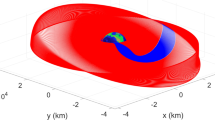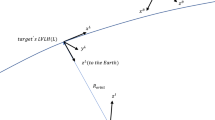Abstract
A recursive application of approximate feedback linearization is applied to low-Earth circular orbit rendezvous utilizing continuous low thrust propulsion. A family of solutions is established up to the \(\rho \)-th degree utilizing the null space that appears at each step in the computations. A convergence analysis is presented to guarantee that the recursive process converges as \(\rho \rightarrow \infty \). During the recursive computations, patterns were detected as part of the solution process that illuminated a family of exact nonlinear control solutions obtained by judiciously selecting the null space coefficients. Examples of various analytic solutions are presented. The relationship between the \(\rho \)-th degree exact solution obtained through the recursive approximations and a known exact solution is illustrated where it is shown that different exact solutions can have different performance in terms of fuel usage leading to the possibility of optimization considerations in selecting the desired exact solution.



Similar content being viewed by others
References
Hermann R (1968) The formal linearization of a semisimple Lie algebra of vector fields about a singular point. Trans Am Math Soc 130:105–109. https://doi.org/10.1090/S0002-9947-1968-0217225-7
Brockett RW (1976) Nonlinear systems and differential geometry. Proc IEEE 64(1):61
Sussmann HJ (1983) Lie brackets, real analyticity and geometric control. Differ Geom Control Theory 27:1
Isidori A, Krener A (1982) On feedback equivalence of nonlinear systems. Syst Control Lett 2(2):118
Krener AJ (1984) Approximate linearization by state feedback and coordinate change. Syst Control Lett 5(3):181
Willson SS, Müllhaupt P, Bonvin D (2013) A quotient method for designing nonlinear controllers. Eur J Control 19(1):42
Tall IA, Respondek W (2002) Feedback classification of nonlinear single-input control systems with controllable linearization: normal forms, canonical forms, and invariants. SIAM J Control Optim 41(5):1498
Tall IA (2010) State and feedback linearizations of single-input control systems. Syst Control Lett 59(7):429
Tall IA (2016) Feedback and partial feedback linearization of nonlinear systems: A tribute to the elders. In: Lee D, Burg T, Volos C (eds) Nonlinear systems - design, analysis, estimation and control. IntechOpen. https://doi.org/10.5772/64689. Available from: https://www.intechopen.com/books/nonlinear-systems-design-analysis-estimation-and-control/feedback-and-partial-feedback-linearization-of-nonlinear-systems-a-tribute-to-the-elders
Khosravi P, Bishop RH (2017) In: 2017 IEEE conference on control technology and applications (CCTA), pp 1817–1822
Karahan S (1989) Higher-degree linear approximations of nonlinear systems. Technical report, California University, Davis, CA (USA)
Fehse W (2003) Automated rendezvous and docking of spacecraft, vol 16. Cambridge University Press
Di Cairano S, Park H, Kolmanovsky I (2012) Model predictive control approach for guidance of spacecraft rendezvous and proximity maneuvering. Int J Robust Nonlinear Control 22(12):1398
Weiss A, Baldwin M, Erwin RS, Kolmanovsky I (2015) Model predictive control for spacecraft rendezvous and docking: strategies for handling constraints and case studies. IEEE Trans Control Syst Technol 23(4):1638
Park C, Guibout V, Scheeres DJ (2006) Solving optimal continuous thrust rendezvous problems with generating functions. J Guid Control Dyn 29(2):321
Marec JP (2012) Optimal space trajectories, vol 1. Elsevier
Wong H, Kapila V, Sparks AG (2002) Adaptive output feedback tracking control of spacecraft formation. Int J Robust Nonlinear Control 12(2–3):117
Singla P, Subbarao K, Junkins JL (2006) Adaptive output feedback control for spacecraft rendezvous and docking under measurement uncertainty. J Guid Control Dyn 29(4):892
Kristiansen R, Nicklasson PJ (2009) Spacecraft formation flying: a review and new results on state feedback control. Acta Astronautica 65(11–12):1537
Alfriend K, Vadali SR, Gurfil P, How J, Breger L (2009) Spacecraft formation flying: dynamics, control and navigation, vol 2. Elsevier
Isidori A (2013) Nonlinear control systems. Springer
Khosravi P (2018) On the application of recursive nonlinear state transformations and nonlinear feedback to enable continuous thrust spacecraft orbital rendezvous. Ph.D. thesis, University of South Florida
Deutscher J, Schmid C (2006) A state space embedding approach to approximate feedback linearization of single input nonlinear control systems. Int J Robust Nonlinear Control 16(9):421
Boas ML (2006) Mathematical methods in the physical sciences. Wiley
Author information
Authors and Affiliations
Corresponding author
Rights and permissions
About this article
Cite this article
Khosravi, P., Bishop, R.H. Circular orbit transfer employing recursive nonlinear state transformations and nonlinear feedback. Int. J. Dynam. Control 10, 180–193 (2022). https://doi.org/10.1007/s40435-021-00799-z
Received:
Revised:
Accepted:
Published:
Issue Date:
DOI: https://doi.org/10.1007/s40435-021-00799-z




